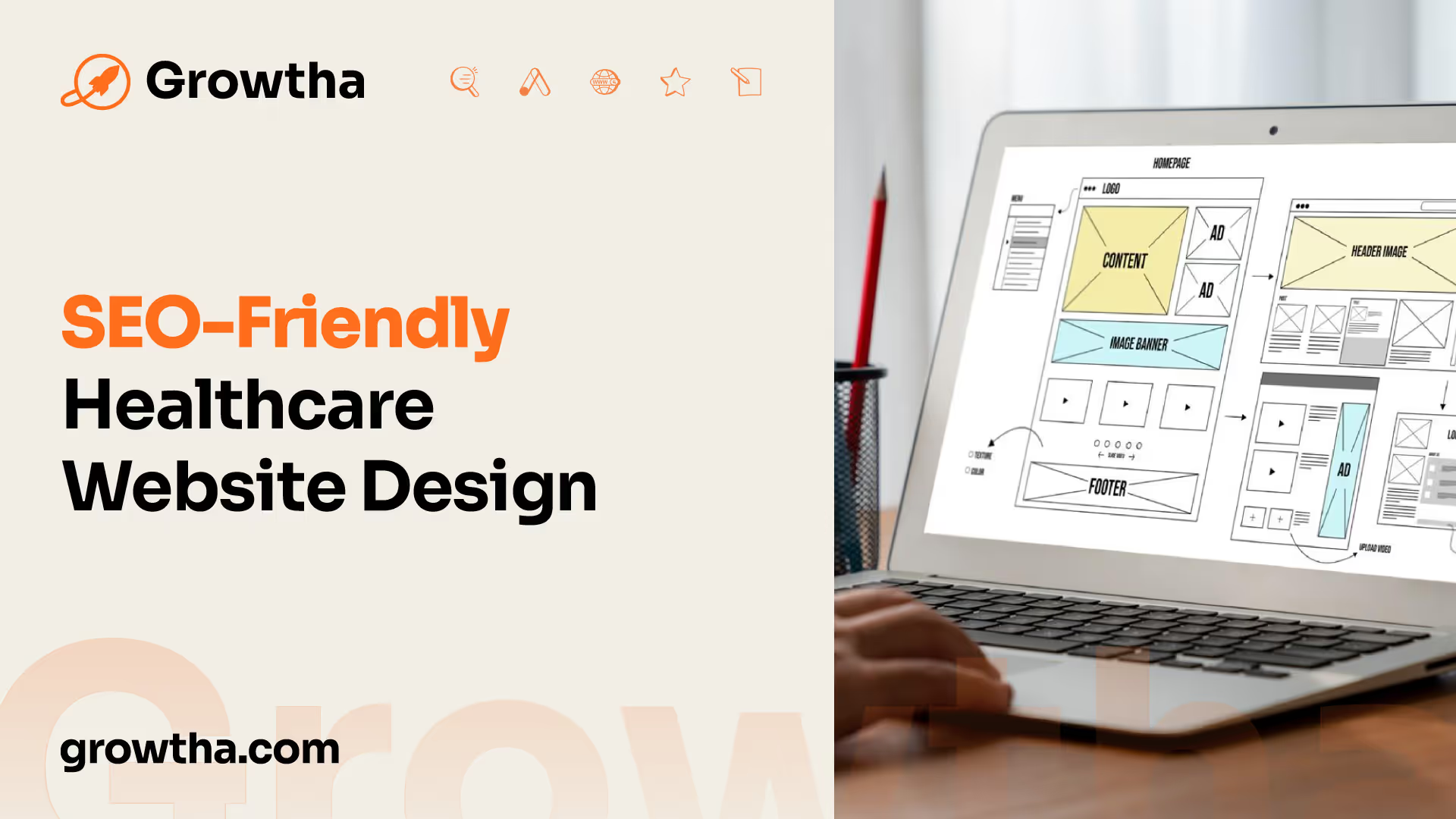SEO-Friendly Healthcare Website Design
By implementing effective search engine optimization (SEO) strategies, healthcare providers can enhance their online visibility and attract targeted traffic to their websites.


SEO-Friendly Healthcare Website Design
The Importance of Healthcare SEO
In the digital age, having an SEO-friendly healthcare website design is crucial for the success of healthcare marketing efforts. By implementing effective search engine optimization (SEO) strategies, healthcare providers can enhance their online visibility and attract targeted traffic to their websites.
Enhancing Online Visibility
Having a strong online presence is essential for healthcare providers to connect with their target audience. When healthcare websites are optimized for SEO, they have a higher chance of ranking higher in search engine results pages (SERPs). This increased visibility allows potential patients to find and access healthcare information and services more easily.
According to Get Found Quick, healthcare websites that rank higher in SERPs due to SEO practices are more likely to attract organic traffic. Organic traffic refers to visitors who find the website through non-paid search engine results. By attracting more organic traffic, healthcare providers can increase their brand credibility and establish themselves as reputable sources of information and services.
Attracting Targeted Traffic
One of the key benefits of healthcare SEO is the ability to attract targeted traffic to a website. By using relevant keywords and optimizing content, healthcare providers can ensure that their website appears in search results for specific queries related to their services. This helps in attracting users who are actively searching for healthcare information or looking for specific medical services.
Effective healthcare SEO strategies focus on optimizing site speed, mobile responsiveness, and using relevant keywords to attract the right audience [1]. For example, implementing local SEO techniques can help target potential patients in specific geographic areas, increasing visibility and appointments. By tailoring SEO efforts to the specific needs and preferences of the target audience, healthcare providers can attract the right traffic and improve the chances of converting visitors into patients.
To enhance the online visibility and attract targeted traffic, healthcare providers should invest in an SEO-friendly website design. By optimizing various aspects of the website, such as site speed, mobile-friendliness, and relevant content, healthcare providers can ensure that their website is easily accessible, user-friendly, and aligned with the needs of their target audience.

Components of Effective Healthcare SEO
To achieve a successful healthcare website that ranks well on search engine result pages (SERPs), it's essential to focus on three key components of effective healthcare SEO: on-page optimization, off-page optimization, and technical optimization.
On-Page Optimization
On-page optimization plays a crucial role in improving a healthcare website's SEO score and visibility on SERPs. This component involves optimizing various elements directly on the website itself. Key strategies for on-page optimization include:
- Keyword Research and Implementation: Conducting thorough keyword research to identify relevant terms and phrases that potential patients may search for. Incorporating these keywords naturally into titles, content, headings, and meta tags can help search engines understand the website's relevance to specific queries.
- High-Quality and Relevant Content: Creating informative, engaging, and valuable content that resonates with the target audience. This not only helps to improve search rankings but also establishes the healthcare brand as a trusted authority in the industry. Content should be regularly updated to keep it fresh and relevant.
- Metadata Optimization: Optimizing meta tags, including title tags, meta descriptions, and header tags, to provide concise and accurate information about the webpage's content. Incorporating target keywords naturally into these tags can enhance search rankings and click-through rates.
- URL Structure: Creating clean and user-friendly URLs that include relevant keywords. This aids both search engines and users in understanding the webpage's content and purpose.
Plugins like Rankmath or Yoast SEO can be helpful in implementing on-page optimization strategies.
Off-Page Optimization
Off-page optimization focuses on increasing a healthcare website's visibility and authority through activities conducted outside of the website itself. The primary strategy for off-page optimization is building high-quality backlinks from reputable websites in the healthcare or medical industry. By collaborating with other websites that have good traffic related to healthcare or medicine, a healthcare website can increase its visibility and credibility. Backlinks serve as endorsements and signals to search engines that the website is trustworthy and relevant [2].
Technical Optimization
Technical optimization involves addressing various technical aspects of a healthcare website to enhance its overall performance and user experience. Some important technical optimization strategies include:
- Website Speed and Performance: Ensuring that the website loads quickly and efficiently. Slow-loading websites can negatively impact user experience and search rankings. Optimizing images, leveraging caching mechanisms, and minimizing server response time are all crucial for improving website speed.
- Mobile-Friendly Design: Designing the website to be responsive and accessible on different devices, particularly mobile devices. With the increasing number of users accessing the internet via mobile devices, having a mobile-friendly website is essential for both user experience and search rankings.
- User-Friendly Navigation: Creating a logical and intuitive website structure that allows users to easily navigate through different pages and find relevant information. Clear and organized navigation menus, breadcrumb trails, and internal linking can contribute to a positive user experience and improve search rankings.
Technical optimization ensures that search engines can effectively crawl and understand the website's content, resulting in better search visibility and user engagement.
By implementing these components of effective healthcare SEO, healthcare brands can improve their website's performance, visibility, and reach. It's important to continuously monitor and optimize these components to stay ahead of algorithm changes and ensure long-term benefits for the healthcare brand.

Key Strategies for Healthcare Website Design
When it comes to healthcare website design, there are several key strategies that can help optimize your website for search engines and improve the overall user experience. Three important aspects to consider are mobile-friendly design, site speed and performance, and user-friendly navigation.
Mobile-Friendly Design
In today's digital landscape, having a mobile-responsive website is essential for healthcare companies. Over 60% of online searches now come from mobile devices, and the percentage of web traffic from mobile devices has been steadily increasing. Moreover, 52% of consumers are using smartphones, tablets, and media devices to search for healthcare providers and access healthcare information [3].
A mobile-friendly design ensures that your website is optimized for viewing on various screen sizes and devices. It enables users to easily navigate and interact with your site, regardless of whether they are using a desktop computer, smartphone, or tablet. This not only enhances the user experience but also establishes credibility for your healthcare brand online [3].
Without a mobile-responsive website, you risk losing potential patients as users tend to leave sites that don't meet their mobile viewing needs. Research shows that 61% of users would quickly move on to another site if they can't find what they need immediately on a mobile site [3]. By investing in a mobile-friendly design, you can attract and retain more visitors, ultimately leading to increased conversions and patient engagement.
Site Speed and Performance
Site speed and performance play a crucial role in the success of your healthcare website. Google has emphasized the importance of site speed as a ranking factor since 2010 [4].
A fast-loading website not only improves the user experience but also contributes to higher search rankings. Research conducted by Google showed that websites with good mobile user experiences tend to have lower bounce rates, leading to increased visibility on search engines. To optimize site speed and performance, consider implementing techniques such as compressing images, minifying CSS and JavaScript files, and utilizing caching mechanisms.
User-Friendly Navigation
User-friendly navigation is vital for healthcare websites to ensure that visitors can easily find the information they are seeking. A well-organized and intuitive navigation menu helps users navigate through different sections of your website, allowing them to locate relevant healthcare services, resources, and contact information with ease.
Consider grouping related pages together under clear and descriptive menu headings. Implementing a search bar can also enhance navigation by enabling users to search for specific information. Additionally, including breadcrumbs or a sitemap can further aid users in understanding the structure of your website and finding their way back to previous pages.
By focusing on mobile-friendly design, site speed and performance, and user-friendly navigation, you can create a healthcare website that not only ranks well in search engines but also provides a seamless and positive experience for your visitors. These key strategies will help ensure that your website is accessible, engaging, and easy to navigate across various devices, ultimately attracting and retaining more patients for your healthcare brand.
Optimizing Content for Healthcare SEO
To maximize the effectiveness of healthcare SEO, it's essential to optimize the content on your website. This includes conducting keyword research and implementation, creating high-quality and relevant content, and optimizing metadata.
Keyword Research and Implementation
Keyword research is a fundamental step in on-page SEO for healthcare websites. It involves identifying keywords and phrases that are relevant to your practice and incorporating them into your website content and metadata. This helps search engines understand the focus of your website and improves your chances of ranking higher in search results. Common keywords for healthcare websites include the practice's name, services offered, and practice location.
By conducting thorough keyword research, you can uncover valuable insights into the terms and phrases that your target audience is searching for. This allows you to tailor your content to meet their needs and increase the likelihood of attracting relevant traffic to your website. Including these keywords naturally throughout your content and metadata can significantly enhance your website's visibility in search engine results.
High-Quality and Relevant Content
Creating high-quality and relevant content is crucial for healthcare SEO. It not only helps enhance search rankings but also establishes your practice as a trusted authority in the industry. By providing valuable and informative content to your target audience, you can build credibility and foster trust. This can lead to increased engagement, improved search rankings, and ultimately, more conversions.
When developing content for your healthcare website, consider the needs and interests of your target audience. Address common questions and concerns, provide educational information, and offer insights into your practice's expertise. By focusing on content that is valuable, well-researched, and unique, you can differentiate your website from competitors and attract a loyal following.
Metadata Optimization
Metadata optimization plays a critical role in healthcare website SEO. It involves optimizing various aspects, including meta tags (title, description, header tags), schema, content structure, and URLs. By naturally incorporating target keywords into these elements, you can improve search rankings and increase the visibility of your website.
When optimizing meta tags, ensure that they accurately reflect the content of each page and incorporate relevant keywords. Craft compelling and concise meta descriptions that entice users to click through to your website from search engine results pages. Additionally, use header tags (H1, H2, etc.) to structure your content and make it more scannable for both users and search engines.
Schema markup is another important aspect of metadata optimization. It provides search engines with additional information about your practice, such as location, opening hours, and services offered. Implementing schema markup can enhance your website's visibility in search results and improve click-through rates.
By paying attention to these content optimization strategies, you can enhance the visibility of your healthcare website, attract targeted traffic, and establish your brand as a trusted authority in the industry. Remember to keep your content high-quality, relevant, and optimized for both users and search engines.
The Role of Local SEO in Healthcare
In the world of healthcare marketing, implementing local SEO techniques is crucial for healthcare providers looking to enhance their online visibility and attract targeted patients in specific geographic areas. By optimizing their website for local search results, healthcare practices can effectively target potential patients in their vicinity, leading to increased visibility and appointments.
Targeting Local Patients
A strong local SEO strategy allows healthcare providers to connect with potential patients in their geographic area. By incorporating local keywords into their website content, healthcare practices can improve their visibility in local search results. For example, a dental practice in Los Angeles can optimize their website for keywords like "Los Angeles dentist" or "dental implants in Los Angeles" [5]. This targeted approach helps healthcare providers reach their intended audience and increase the chances of attracting local patients.
Google Business Profile Optimization
Optimizing the Google Business Profile is a crucial aspect of local SEO for healthcare providers. This free tool allows healthcare practices to manage their online presence and provide accurate information to potential patients. By optimizing their Google Business Profile with relevant keywords, accurate contact information, business hours, and patient reviews, healthcare practices can improve their visibility in local searches. This optimization helps potential patients find the practice more easily and builds trust and credibility.
Encouraging Online Reviews
Positive online reviews play a vital role in building trust and credibility with potential patients. Encouraging patients to leave reviews on popular search engines and review sites can significantly impact a healthcare practice's online reputation. Positive reviews not only attract potential patients but also help healthcare providers rank higher in local search results. Maintaining a strong online presence and actively managing patient reviews can contribute to the success of a healthcare practice's local SEO efforts [6].
By incorporating local SEO techniques, healthcare providers can effectively target their local audience, optimize their online presence, and encourage positive patient engagement. These strategies, including targeting local patients, optimizing the Google Business Profile, and encouraging online reviews, can significantly enhance the success of a healthcare practice's digital marketing efforts.
Building Trust and Credibility
In the competitive landscape of healthcare marketing, building trust and credibility is paramount. A well-designed website that incorporates certain elements can enhance the reputation of a healthcare brand. In this section, we will explore three key aspects: backlink building, social media integration, and clear calls to action.
Backlink Building
Backlink building plays a crucial role in establishing trust and credibility for healthcare websites. By acquiring high-quality backlinks from reputable sources, a website can enhance its authority and improve search engine rankings. These backlinks act as a vote of confidence from other websites, indicating that the content is reliable and trustworthy.
To build backlinks, healthcare organizations can collaborate with authoritative websites, such as industry associations, medical journals, and reputable healthcare blogs. Engaging in guest blogging, creating informative and valuable content, and actively participating in relevant online communities can also help attract backlinks from trusted sources.
Social Media Integration
Social media integration is a vital aspect of healthcare website design. Failure to incorporate social media platforms can be a missed opportunity for healthcare organizations to connect with patients, promote services, and establish an online presence. Leveraging social media platforms helps build trust and credibility with potential patients, as it provides a platform for sharing valuable information, engaging with the community, and showcasing expertise [7].
By integrating social media icons and links on their website, healthcare organizations can encourage visitors to engage with their social media profiles. This allows patients to stay updated with the latest news, events, and health tips. Sharing patient testimonials, success stories, and educational content through social media channels can also contribute to building trust and credibility.
Clear Calls to Action
Including clear calls to action (CTAs) on a healthcare website is essential for guiding visitors towards specific actions. CTAs prompt visitors to take desired actions, such as making appointments, signing up for newsletters, or downloading resources. Clear and strategically placed CTAs enhance user engagement and conversions, ensuring that visitors are not left uncertain about the next steps.
To optimize CTAs, healthcare websites should use action-oriented language that clearly conveys the desired action. CTAs should be strategically placed on relevant pages, such as appointment booking pages, contact forms, or service-specific landing pages. Additionally, incorporating contrasting colors, attention-grabbing buttons, and concise instructions can make CTAs more effective in capturing the attention of visitors and increasing conversions.
By focusing on backlink building, social media integration, and clear calls to action, healthcare websites can establish trust and credibility with their target audience. These elements contribute to a strong online presence, enhance user engagement, and ultimately drive conversions for the healthcare brand.
The Impact of Site Speed on Healthcare SEO
In the world of healthcare SEO, the speed at which a website loads plays a vital role in its overall performance and search engine rankings. This section will explore why site speed is important, how it affects user engagement and website performance, and the significance of responsive design.
Google's Emphasis on Site Speed
Google, a dominant player in the search engine industry, has recognized the significance of site speed for quite some time. In fact, site performance has been a factor in Google's search ranking algorithms since 2010. Google emphasizes the importance of delivering an excellent user experience, and site speed is a component of that experience.
User Engagement and Website Performance
Research conducted by Google has shown that even a slight delay of just half a second can significantly reduce user engagement on a website [4]. This finding is particularly relevant for healthcare websites, as users often seek quick access to medical information and services. If a website takes too long to load, users may become frustrated and abandon it, leading to missed opportunities for engagement, conversions, and potential business growth.
To ensure a positive user experience, healthcare websites should prioritize efficient website loading times. Fast-loading websites not only attract and retain users but also contribute to improved search rankings. It's worth noting that most visitors tend to leave a site if it takes more than 3 seconds to load, and Google recommends a loading time of about 2 seconds, with half a second being ideal for better rankings. By optimizing site speed, healthcare brands can enhance overall website performance and increase the chances of attracting and converting visitors.
Importance of Responsive Design
Another factor that impacts site speed and user experience is responsive web design. Google emphasizes the importance of having a responsive design for healthcare websites, ensuring they are user-friendly across all devices. Responsive design allows websites to adapt to various screen sizes and devices, providing a seamless experience for users. It also ensures that healthcare websites are accessible and easy to navigate, regardless of whether users are accessing them from a desktop computer, smartphone, or tablet.
By implementing responsive design practices, healthcare websites can meet the expectations of modern users who increasingly rely on mobile devices for accessing information and services. Additionally, responsive design can positively impact search rankings, as Google considers mobile-friendliness as a ranking factor.
In summary, the impact of site speed on healthcare SEO cannot be overstated. Fast-loading websites not only enhance user experience and engagement but also contribute to improved search rankings. By optimizing site speed and implementing responsive design, healthcare brands can improve their online visibility, attract targeted traffic, and provide users with fast and accessible healthcare information and services.
Ongoing Investment in Healthcare SEO
To maintain a successful online presence and maximize the benefits of healthcare SEO, it is crucial for healthcare organizations to make an ongoing investment in optimizing their websites. This involves staying up to date with algorithm changes, continuously optimizing and improving the website, and recognizing the long-term benefits of SEO.
Staying Up to Date with Algorithm Changes
Search engines regularly update their algorithms to provide users with the most relevant and valuable search results. Therefore, it is essential for healthcare organizations to stay informed about these changes and adapt their SEO strategies accordingly. By understanding the latest algorithm updates, healthcare websites can make necessary adjustments to their on-page optimization, content strategies, and technical aspects to ensure their websites remain visible and rank well in search engine results.
Continuous Optimization and Improvement
Healthcare organizations should view SEO as an ongoing process rather than a one-time task. Continuous optimization and improvement are key to maintaining and improving search rankings, attracting organic traffic, and increasing patient conversions. Regularly monitoring website performance, analyzing data, and identifying areas for improvement can help healthcare organizations refine their SEO strategies and make necessary adjustments to stay ahead of the competition.
Long-Term Benefits of SEO
Investing in healthcare SEO yields long-term benefits for healthcare organizations. By improving search rankings and increasing online visibility, healthcare websites can attract a steady stream of targeted organic traffic. This can lead to higher patient engagement, increased appointment bookings, and ultimately, better patient outcomes. Additionally, a strong digital presence built through SEO establishes trust and credibility among patients, making healthcare organizations the go-to choice in their respective fields [2].
A continuous investment in healthcare SEO ensures that healthcare organizations remain competitive in the evolving online healthcare landscape. By staying up to date with algorithm changes, continuously optimizing their websites, and recognizing the long-term benefits of SEO, healthcare organizations can maximize their online visibility, attract more patients, and ultimately achieve their business goals.
References
[1]: https://www.getfoundquick.com/5-reasons-why-seo-is-important-for-the-healthcare-industry/
[2]: https://www.linkedin.com/pulse/what-importance-seo-optimization-ranking-healthcare-website-ahmed
[3]: https://pyxl.com/blog/the-case-for-a-mobile-responsive-website-in-healthcare/
[4]: https://developers.google.com/search/blog/2010/04/using-site-speed-in-web-search-ranking
[5]: https://www.linkedin.com/pulse/3-core-components-strong-healthcare-seo-strategy-digitalismedical







